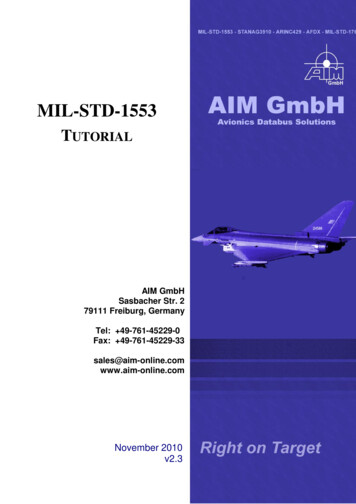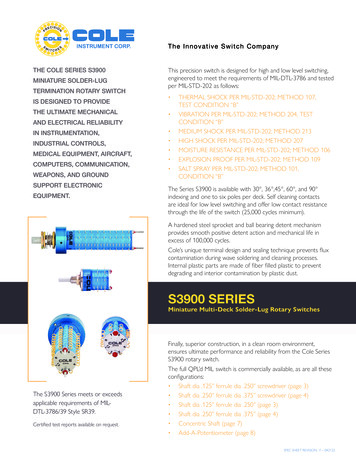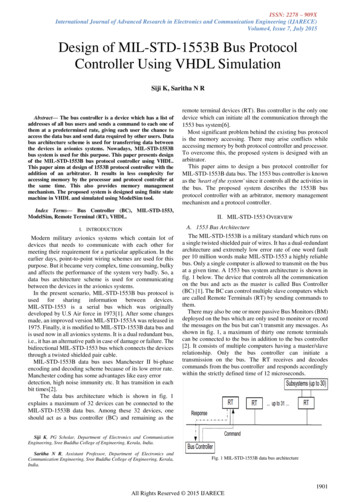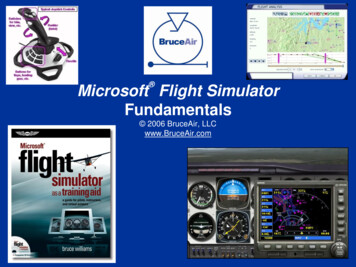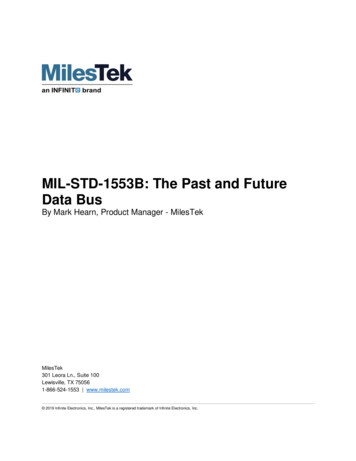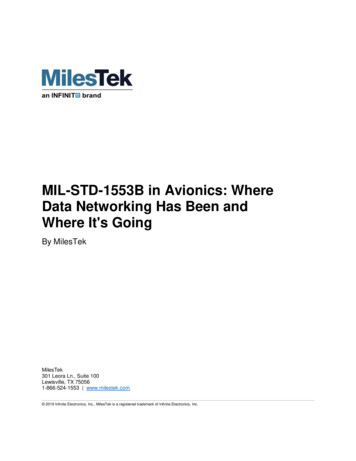
Transcription
MIL-STD-1553B in Avionics: WhereData Networking Has Been andWhere It's GoingBy MilesTekMilesTek301 Leora Ln., Suite 100Lewisville, TX 750561-866-524-1553 www.milestek.com 2019 Infinite Electronics, Inc., MilesTek is a registered trademark of Infinite Electronics, Inc.
MIL-STD-1553B in Avionics: Where Data Networking HasBeen and Where It's GoingThe landscape of avionics architectures has shifted through the decades from analog to digital systemimplementations with increased software complexities. As the subsystems of the aircraft grow, so do thecomplexities in the communications between them. Speed, reliability, safety, cost, and quality of serviceare all factors that are taken into consideration when choosing a particular data networking standard. Thepresent evolution in technology and data networking--of which, MIL-STD-1553B has and is still a majorcomponent--offers a wide variety of options for modern day aircraft.However, increased data throughput requirements for high definition video and camera services farexceed what MIL-STD-1553B theoretically maximums are-- approximately 200 Mbps. Efforts have beenmade to provide enhanced speed MIL-STD-1553B, which may still serve some purposes on commercialaircraft. Moreover, technologies such as Ethernet, are more likely to succeed in meeting the latestthroughput demands commercial, and possibly, military avionics.Caption: As the complexity of subsystems grows so do data networking standards for both military andcommercial avionics.Source: Design and Development of Aircraft Systemshttps://books.google.com/books?id kD ZC5GzqeIC&pg PA98&dq distributed digital architecture arinc 429&hl en&sa X&ved 0ahUKEwiK0Y2L0MnSAhUj4oMKHRZ DPYQ6AEIKTAC#v onepage&q &f falsewww.milestek.com 1-866-524-1553 2019 Infinite Electronics, Inc., MilesTek is a registered trademark of Infinite Electronics, Inc.2
A Timeline of Avionics ArchitecturesCaption: Timeline of avionics roumov/avionics-digital-data-busesDistributed AnalogIn the 1960s, the initial distributed analog avionic systems were of a single source-single sink applicationwhere a single computer could send commands to a single piece of equipment. This type of dedicatedlinking with simplex transmission, or a transmission that can only go in one direction, could be used inearlier aircraft with minimal subsystems. As the complexity of avionic data systems increased, so did theinterdependency between equipment. This architecture rapidly presented limitations as aircrafts gainedmore subsystems, and the original analog system proved very difficult to modify as there were no busesand only wires and bulky electromechanical parts.www.milestek.com 1-866-524-1553 2019 Infinite Electronics, Inc., MilesTek is a registered trademark of Infinite Electronics, Inc.3
Caption: Schematic of a sample electromechanical flight deck implementing a distributed analogarchitecture.Source: multimodal digital avionics for commercial applications.pdfDistributed DigitalIn the late 1960s and early 1970s, the advent and maturation of digital computing led to distributed digitalarchitectures with single source-multiple sink data transmission. This was practiced with standards suchas ARINC 429, or Mark33 Digital Information Transfer System (DITS), as a serial unidirectional digitaldata bus. This technique enables one piece of transmitting equipment, or source, to communicate with 120 subsystems, or sinks. Still, this standard relies on a simplex transmission on one twisted shielded pairdata line, and bi-directional data transfer necessitates two lines. This data protocol was adopted primarilyin commercial aircraft as the point-to-point wiring structure provides highly reliable data transfer at aspeed of approximately 100 kbs/s.There are a limited number of topologies to leverage when designing an ARINC 429 system. Everytransmitting line replaceable unit (LRU) must be connected to up to 20 receiving LRUs, such as radaraltimeters, radios, and GPS sensors in various formations. Upgrades on this type of aircraft are verydifficult considering the wiring challenges, as each subsystem was dedicated in function. Also, much ofthe equipment required custom design with almost no commercial off-the-shelf (COTS) hardware options.Sample aircraft with an ARINC 429 installation includes the Airbus A310/A320 and A330/A340, BellHelicopters, Boeing 727, 737, 747, 757, and 767, and McDonnell Douglas MD-11.www.milestek.com 1-866-524-1553 2019 Infinite Electronics, Inc., MilesTek is a registered trademark of Infinite Electronics, Inc.4
Caption: Advancements in computerized components allows for the addition of ARINC 429 digitalcomponents such as Flight Management System (FMS).Source: multimodal digital avionics for commercial applications.pdfFederated DigitalThe military standard MIL-STD-1553, or Digital Internal Time Division Command/Response MultiplexData Bus, was first released in 1973 and solidified the federated digital avionic architectures for themilitary while multiple ARINC 429 buses were still leveraged more often in the commercial arena. Thismultiple source-multiple sink system is a type of half-duplex serial data transmission between criticalcomponents, or subsystems, on an aircraft. Since its inception in 1973 this standard has proven robustand highly modular. MIL-STD-1553 has been implemented in wider range of applications includingcommercial aircraft, submarine, and space avionics systems. The high reliability of the 1553 standardwww.milestek.com 1-866-524-1553 2019 Infinite Electronics, Inc., MilesTek is a registered trademark of Infinite Electronics, Inc.5
stems from several factors which enable the bus controller (BC) to detect errors and recheck to see if anycomponents, or remote terminals (RT), are malfunctioning. The addition of an extra bus (dual-redundantbus), and a backup BC in critical instances. Helped to avoid failure if the primary BC crashed.MIL-STD-1553 exhaustively lists design and implementation methods of an avionics system, frommessage commands to RT layouts, which has simplified the adoption of the standard across platformsand technologies through the decades. The federated digital architecture allows for a more interrelatedfunctionality between systems that were previously independent in architectures of the past. Datatransmission via buses drastically cut down on the weight and cost that traditional point-to-point systemstypical required. For instance, the United States Air Force saved approximately 1,200 pounds in wire forthe B-52 [8]. The 1553 system has become so prevalent over the decades that close to 30,000 aircraftleverage the standard with nearly 1 million total 1553 terminals implemented [9].Caption: F-105 Thunderchief with LRUs laid out. Federated architectures mitigated the amount of wiringbetween discrete components and streamlined aircraft controls.Source: :Republic F-105B with avionics layout 060831-F1234S-046.jpgwww.milestek.com 1-866-524-1553 2019 Infinite Electronics, Inc., MilesTek is a registered trademark of Infinite Electronics, Inc.6
Integrated ModularWhile the military standard MIL-STD-1553B’s system modularity and redundancy ultimately allowed forswift upgrades to subsystems as technology evolved―ARINC 429 was rapidly becoming outdated,expensive, and bulky for commercial airliners. Commercial aircraft did not need the level of upgradesmilitary aircraft call for, this way a highly specialized and integrated system is a feasible option for manyyears.However, the desired for increased data rates on aircraft led to the development of the ARINC 653standard, which was developed in 1996 after a slow evolution from the widely used ARINC 429. Thisstandard outlines the general purpose hardware and software for an IMA architecture. The data networkdevelopment of fourth generation jet fighters (e.g.: F-22, F-35, etc.) led to the early phases of IMAconcept, but was eventually more readily adapted by commercial industries.Where components in federated networks generally function with independent operating systems perhardware module, integrated modular networks allow for a layer of abstraction between the hardware andsoftware, in order to more swiftly allocate resources to and from any subsystem of the aircraft. Thesehighly integrated systems often leverage the avionics full-duplex switched Ethernet (AFDX) data networkwith the APEX application program interface (API), as specified in ARINC 664 part 7 for datacommunications.This data networking essentially replaced the point-to-point connections of ARINC 429 with virtual links(VL) over a highly integrated physical network of avionics. The AFDX network leverages twisted pair orfiber optic cables to accomplish full-duplex Ethernet transmission with two separate pairs for the transmitand receive paths. This approach prevents transmission collisions. Switches are a core component of thissystem and establish a distribution network of all information packets. The IMA system has already beenimplemented in a number of aircraft including the Airbus A350/A380/A400M, Boeing 777/787, DassaultFalcon 900, BAE Hawk, and the ATR 42/72.www.milestek.com 1-866-524-1553 2019 Infinite Electronics, Inc., MilesTek is a registered trademark of Infinite Electronics, Inc.7
Caption: Modern day aircraft feature a complex FMS with a centralized processing system.Source: multimodal digital avionics for commercial applications.pdf1553B: Looking Forward155B StrengthsCharacteristics such as scalability, determinism, maturity, and interoperability give MIL-STD-1553Bsystem an edge over many alternatives. This standard has had decades to steadily absorb intoapplications across industries. Thus, allowing for agile design capabilities, while established software andGUIs provide ease of simulation. Moreover, COTS components come available with the dual-bus systembuilt into their specifications, thereby easing the design process. Vehicle or aircraft upgrades can bedeveloped in parallel as opposed to linearly, as subsystems with 1553B are not tightly integrated.www.milestek.com 1-866-524-1553 2019 Infinite Electronics, Inc., MilesTek is a registered trademark of Infinite Electronics, Inc.8
One cornerstone trait of MIL-STD-1553B is transmission reliability, that culminates as vastly less risk andcost in implementing it versus other avionic standards. The bit error rate (BER) with 1553B is a low 10 -12,so only a minimum bus bandwidth is used for retransmission. Ultimately, the low BER enables highersystem throughput. There are many buffers to prevent a catastrophic failure in this architecture, such asthe fail-safe timer, which prevents any transmission on the bus longer than 800us that may render the busunusable for other transmissions. Also, the use of coupled transformers isolates subsystems, preventingpower surges or electromagnetic interference (EMI) from disrupting system performance. These featuresallow for a graceful degradation and a longer lifespan of the aircraft.1553B Areas for ImprovementWhile a centralized bus control facilitates predictability, this design can limit software modularity and thereconfigurability of resources. The increasing number of complex subsystems and the possible necessityto stream vast amounts of information on military aircraft, may cause challenges in relying on MIL-STD1553B’s in the future. System throughput via this architecture is limited to a maximum single-commandsize of 32 words. It is also not possible to access the BC and RT simultaneously, as the data busoperates asynchronously with a half-duplex transmission. The 1553B bus uses a shared path, which canaccommodate one subsystems to communicate and there is no parallel processing in this regard.IMA DrawbacksMuch of the obstacles in deploying a 1553B system comes down to throughput. Comparing 1553B withthe IMA architecture, IMA boasts a higher maximum data rate, with the AFDX protocols reaching speedsup to 100 Mbit/s. The 1553B architecture provides high reliability with a real-time deterministic system anda series of redundancies for mission-critical scenarios. While there are many major improvements overprevious technologies, implementing an IMA system can be very involved due to the complexity inpartitioning off the wide variety of applications with AFDX data networking. The 1553B system specifiesthat the BC send commands to the RTs at predetermined times and monitors message requestsaccording to a set of fixed instructions. The instructions can be manipulated to be able to respond toperiodic or intermittent signals in wide array of circumstances, which gives 1553B the deterministicquality. Hence, a 1553B system can be pre-programmed for precise command/response timings―thiscannot be done in the IMA architecture. While the IMA architecture has become a highly desirablealternative in commercial aerospace, it has yet to become common enough in military applications forwide deployment and to benefit from infrastructure advantages.Caption: A side-by-side comparison of the (a) federated network architecture versus the (b) integratedmodular avionics (IMA) architecture. The integrated system improves speed and latency of the network butcan create complexity in upgrades and retrofits.Source: 12-08-1/NET-2012-08-1 09.pdfwww.milestek.com 1-866-524-1553 2019 Infinite Electronics, Inc., MilesTek is a registered trademark of Infinite Electronics, Inc.9
1553B: Increasing ThroughputThe 1553B system has proven a robust and effective method to realize communication and theintegration of avionics equipment. Since the first release in 1973 (MIL-STD-1553A), the shift to MIL-STD1553B in 1978 was to more strictly outline networking protocols to have consistency across all militaryembedded applications. There were only minor adjustments to this standard from 1978 onwards with sixdifferent change notices that primarily altered wording in the original document to imply use acrossapplications beyond military.In 2006, Edgewater Computer Systems of Canada took successful steps towards increasing 1553B databus speeds to 200 Mbits/s with minimal retrofits and alterations to the currently incorporated systems,under a grant from the military. This system was in its early phases and was flight-tested in an Air ForceF-16 jet fighter with promising results. The program has since been terminated due to a cut of funding, butthe project illuminated the high speed potential of the 1553 topology.DDC, a Bohemia, NY based 1553 technology company, also developed high-speed 1553B options in2006, including ‘Turbo-1553’ and ‘HyPer-1553’ that accomplished comparable speeds to EdgewaterComputer Systems. HyPer-1553 was flight tested on a Boeing F-15E Strike Eagle jet fighter-bomber.Using augmentations to the MIL-STD-1553B architecture, without generating a complete paradigm shiftfrom 1553B system design, may allow for less complex and costly installations and maintenance forretrofits and new aircraft designs, increasing the longevity of MIL-STD-1553B. More likely, however, isthat high throughput demands will continue to promote the development and implementation of other highspeed avionics communications equipment, where needed.ConclusionData networking architectures have experienced drastic shifts with the exponential technologicaladvancements. Currently, there are trade-offs between choosing a highly integrated system with lowlatency and a high throughput with a more discrete system with high determinism, low risk, andinteroperability. MIL-STD-1553B is a tremendous reliable communications architecture that may still servefor years to come. The IMA architecture offers great advantages in commercial aircraft, but has yet to findtrue practical implementation. However, newer technologies built for the digital age, such as Ethernet andIP-based networking, may be adapted to the reliability and performance standards of commercial andmilitary avionics.Resources:1. http://www.milestek.com/s-145-mil-std-1553b.aspx2. ide/designers-notes/3. CE%2021.pdf4. Alta Data Technologies ‘MIL-STD-1553 Tutorial and Reference’5. https://en.wikipedia.org/wiki/Integrated modular avionics6. 12-08-1/NET-2012-08-1 09.pdf7. al-data-buses8. cus-1553-still-a-key-standard/9. es-and-1553.html10. http://oatao.univ-toulouse.fr/198/1/Mifdaoui 198.pdf11. article 2107&context smallsat12. rmance/This article was originally published in Intelligent Aerospacewww.milestek.com 1-866-524-1553 2019 Infinite Electronics, Inc., MilesTek is a registered trademark of Infinite Electronics, Inc.10
present evolution in technology and data networking--of which, MIL-STD-1553B has and is still a major component--offers a wide variety of options for modern day aircraft. However, increased data throughput requirements for high definition video and camera services far exceed what MIL-STD-1553B theoretically maximums are-- approximately 200 Mbps.
